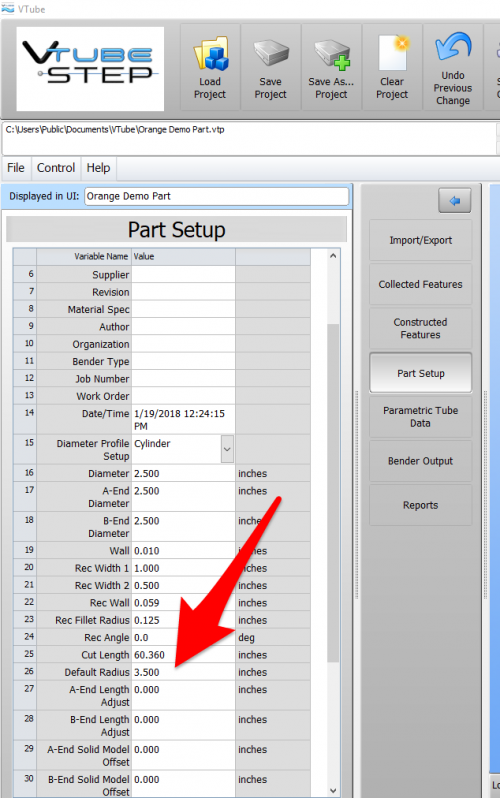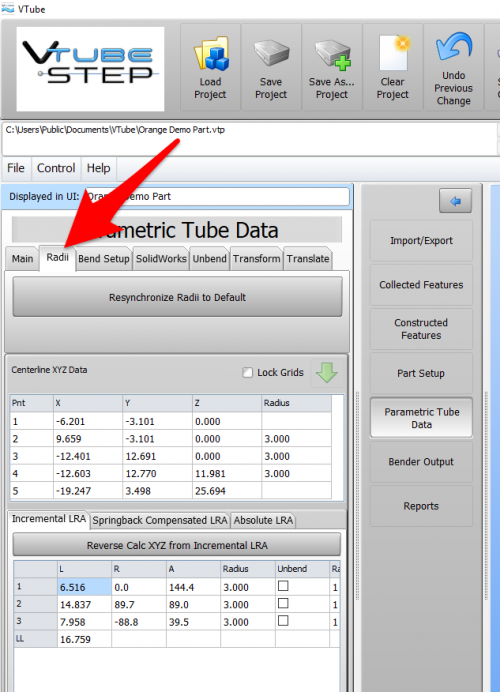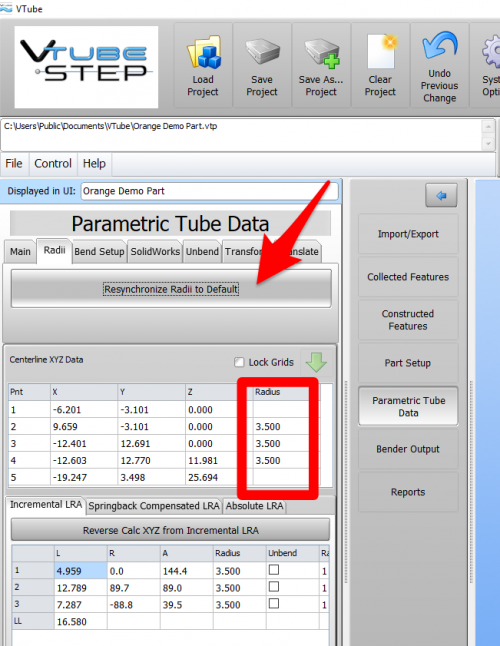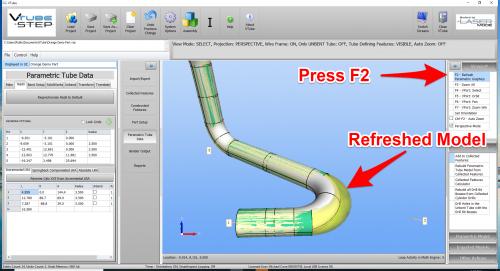|
|
| (9 intermediate revisions by one user not shown) |
| Line 5: |
Line 5: |
| | <tr valign=top> | | <tr valign=top> |
| | <td width=300> | | <td width=300> |
| − | How to set the XYZ radii to the Part Setup default radius.<br><br>These steps work the same in both LASER and STEP modes.
| + | This article shows how to quickly propagate radii values to other parts of VTube-LASER and VTube-STEP using the DEFAULT RADIUS value.<br><br>These steps work the same in both LASER and STEP modes. |
| | <br><br> | | <br><br> |
| | | | |
| Line 15: |
Line 15: |
| | | | |
| | * Back to [[VTube-LASER]] | | * Back to [[VTube-LASER]] |
| − | * Back to [[VTube-STEP]] | + | * Back to [[VTube-STEP]]<br><br> |
| | __TOC__ | | __TOC__ |
| | | | |
| − | =Purpose of the Default Radius= | + | =STEP 1 - Enter the DEFAULT RADIUS= |
| | <table width=900> | | <table width=900> |
| | <tr valign=top> | | <tr valign=top> |
| Line 36: |
Line 36: |
| | <table width=900> | | <table width=900> |
| | <tr valign=top> | | <tr valign=top> |
| − | <td width=500> | + | <td width=300> |
| | Enter the XYZ menu. This is the Parametric Tube Data menu in STEP mode, and the either the MASTER TUBE or MEASURED TUBE menus in VTube-LASER mode.<br><br> | | Enter the XYZ menu. This is the Parametric Tube Data menu in STEP mode, and the either the MASTER TUBE or MEASURED TUBE menus in VTube-LASER mode.<br><br> |
| | Click on the Radii tab menu. | | Click on the Radii tab menu. |
| Line 49: |
Line 49: |
| | </table> | | </table> |
| | | | |
| − | =BENDERLINK SETUP STEPS FOR VTUBE-LASER and VTUBE-STEP= | + | =STEP 3 - PRESS the "Resynchronize Radii to Default" BUTTON= |
| | | | |
| − | The setup steps for LASER and STEP are the same.
| |
| | | | |
| − | ===STEP 1: Enter the SYSTEM OPTIONS Menu in VTube===
| + | <table width=900> |
| − | | + | |
| − | <table width=1000> | + | |
| | <tr valign=top> | | <tr valign=top> |
| − | <td width=500> | + | <td width=300> |
| − | | + | Press the button to change all the radii. |
| − | #Click on Systems Options in the toolbar at the top of the screen.<br><br>
| + | |
| − | #Enter the Measure 2 tab menu.<br><br>
| + | |
| − | #Enter the Setup Benderlink Network menu.<br><br>
| + | |
| | </td> | | </td> |
| | <td width=300> | | <td width=300> |
| − | [[image:vtl_v2.9.10_herberbenderlinksetup_enterbenderlinkgrid.png|600px]] | + | [[image:vts_v2.9.10_resync_radii_button.png|500px]] |
| | </td> | | </td> |
| | </tr> | | </tr> |
| Line 70: |
Line 64: |
| | <br><br><br> | | <br><br><br> |
| | | | |
| − | ===STEP 2: Setup the Benderlink Network Grid for HERBER MES Protocol===
| |
| | | | |
| − | Important Note: It may seem confusing to setup for the HERBER MES protocol in this grid when you are using the SOL protocol. However, VTube-STEP and VTube-LASER understand that you intend to use the SOL and MES protocols together for the same bender. If you are using VTube-STEP without VTube-LASER, then please follow these instructions
| |
| − | <table cellpadding=10 width=1100>
| |
| − | <tr valign=top>
| |
| − | <td width=500>
| |
| − | #Choose an unused row in the grid for a new HERBER bender setup.<br><br>
| |
| − | #Assign a bender name that will help operators identify which bender this is. This text will be displayed at the top of the Bender Setup menu.<br><br>
| |
| − | #Assign the HERBER MES protocol.<br><br>
| |
| − | #Enter the path to the shared drive or folder in the NetPath field. This path should point to the HERBER folder that will receive MES files from VTube. (The value shown on the screen is only an example.)<br><br>
| |
| − | #Enter the IP address in the PING IP ADDRESS field if it is a fixed field. (This is not required. It allows VTube to ping the address to see if the network location is active before trying to open communications.)<br><br>
| |
| − | #If the HERBER rotates the Clockwise positive, then select YES in the CW Rotation Positive cell.<br><br>
| |
| − | #Press Close to save the settings. VTube will save these values to a persistent configuration file that will not change unless you change them in this grid.
| |
| | | | |
| − | </td>
| + | =STEP 4 - PRESS the "F2" BUTTON to REFRESH THE PARAMETRICS= |
| − | <td width=300>
| + | |
| − | [[image:vtl_benderlink_herber.png|700px]]
| + | |
| − | </td>
| + | |
| − | </tr>
| + | |
| | | | |
| − | </table>
| |
| − | <br><br>
| |
| − | <br><br>
| |
| − | <br><br>
| |
| | | | |
| − | =[[image:vtube-laser_logo_1.96.png|200px]] How to SEND CORRECTION Data to the HERBER Control from VTube-LASER=
| + | <table width=900> |
| − | | + | |
| − | ===STEP 1 - Bend the Tube===
| + | |
| − | <table cellpadding=10> | + | |
| | <tr valign=top> | | <tr valign=top> |
| | <td width=300> | | <td width=300> |
| − | Bend the tube in the HERBER bender.<br><br>
| + | Pressing F2 will refresh the parametric model and show the radius change like this. |
| − | <td>
| + | |
| − | [[image:HERBER Control Station.png|200px]] [[image:herber bender large tube bending.png|400px]]
| + | |
| | </td> | | </td> |
| − | </tr>
| |
| − | </table>
| |
| − |
| |
| − | ===STEP 2 - Measure the tube with VTube-LASER===
| |
| − | <table cellpadding=10>
| |
| − | <tr valign=top>
| |
| | <td width=300> | | <td width=300> |
| − | Measure and align the tube to determine if it qualifies by falling within the envelope tolerance for the tube shape. <br><br>
| + | [[image:vts_v2.9.10_refreshF2_radiuschange.png|500px]] |
| − | In the screen shot on the right, the red on the top left shows that the first END "A" LENGTH is out of tolerance.<br><br>
| + | |
| − | Also, the red cells in the tangent point grid show that the measured tube centerline shape is out-of-tolerance.<br><br>
| + | |
| − | Also - VTube is very visual. The solid model on the right shows exactly where the part is out is exceeding the tolerance.
| + | |
| − | Click on the image to zoom in to see the values.
| + | |
| − | | + | |
| − | <td>
| + | |
| − | [[image:Vtube-imc screen romer arm.png|500px]]<br><br> | + | |
| − | [[image:VTube-LASER UNISON Inspection Result.png|400px]]
| + | |
| | </td> | | </td> |
| | </tr> | | </tr> |
| | </table> | | </table> |
| | + | <br><br><br> |
| | | | |
| − | ===STEP 3 - Enter BENDER SETUP===
| |
| − | <table cellpadding=10>
| |
| − | <tr valign=top>
| |
| − | <td width=300>
| |
| − | Click on the BENDER SETUP button in the Navigation Pane. <br><br>
| |
| − |
| |
| − | <td>
| |
| − | [[image:VTube-LASER UNISON Click on Bender Setup.png|400px]]<br><br>
| |
| − | </td>
| |
| − | </tr>
| |
| − | </table>
| |
| − |
| |
| − | ===STEP 4 - Choose the BENDER NUMBER===
| |
| − | <table cellpadding=10>
| |
| − | <tr valign=top>
| |
| − | <td width=300>
| |
| − | Set the correct bender number at the top of the window.<br><br>
| |
| − | You can select up to 100 different benders.<br><br>
| |
| − | The Bender Protocol should say "HERBER MES". (This assumes that you have already configured VTube's Benderlink in the Systems Options as described in the previous section.)
| |
| − | </td>
| |
| − | <td>
| |
| − | [[image:vtl_v2.9.10_bendersetup_choosebender_herber.png|400px]]
| |
| − | </td>
| |
| − | </tr>
| |
| − | </table>
| |
| − |
| |
| − | ===STEP 5 - COPY the Data from VTube-LASER's Main Memory===
| |
| − | <table cellpadding=10>
| |
| − | <tr valign=top>
| |
| − | <td width=300>
| |
| − | If this is the first correction, then the Bender Setup screen may show no data. If this is the case, then it is necessary to update the Bender Setup screen from VTube-LASER's main memory like this:<br><br>
| |
| − | * Press "Setup this Window".
| |
| − | * Press "Copy Master LRA to Setup LRA".
| |
| − | </td>
| |
| − | <td>
| |
| − | [[image:vtl_v2.9.10_herber_copy_master_lra_to_setup_lra.png|400px]]<br><br>
| |
| − | </td>
| |
| − | </tr>
| |
| − | </table>
| |
| − |
| |
| − |
| |
| − | ===STEP 6 - OPTIONAL STEP - You Can Manually Change the ADJUSTMENT Values===
| |
| − | <table cellpadding=10>
| |
| − | <tr valign=top>
| |
| − | <td width=300>
| |
| − | You can manually change the ADJUSTMENT values before sending corrections if you want to. Some users like to set the first and last Length adjustment to zero in order to keep the start position of the carriage in the same place - for when they have extra length on the ends.<br><br>
| |
| − | If you want to, it is even possible to invert the rotation direction to keep the tube from hitting the bender during rotations.
| |
| − | <td>
| |
| − | [[image:vtl_v2.9.10 HERBER Manually Adjust Correction Values.png|400px]]<br><br>
| |
| − | </td>
| |
| − | </tr>
| |
| − | </table>
| |
| − |
| |
| − | ===STEP 7 - Send Corrections to the HERBER===
| |
| − | <table cellpadding=10>
| |
| − | <tr valign=top>
| |
| − | <td width=300>
| |
| − | Press "Auto SEND Bender CORRECTIONS". VTube-LASER will let you select a path, then save a MES file to that path.
| |
| − | <td>
| |
| − | [[image:vtl_v2.9.10_herber_send_corrections.png|400px]]<br><br>
| |
| − | </td>
| |
| − | </tr>
| |
| − | </table>
| |
| − |
| |
| − | ===STEP 8 - The SEND to BENDER Complete Window===
| |
| − | <table cellpadding=10>
| |
| − | <tr valign=top>
| |
| − | <td width=300>
| |
| − | A window should appear for a few seconds indicating that the Send to the Bender is complete.<br><br>
| |
| − | You can allow this window to close on its own in a few seconds, or press the close button to close it immediately.
| |
| − | <td>
| |
| − | [[image:vtl_v2.9.10 HERBER Send Adjusted Complete.png|400px]]<br><br>
| |
| − | </td>
| |
| − | </tr>
| |
| − | </table>
| |
| − |
| |
| − | ===STEP 9 - IMPORT the Correction Data at the HERBER Control===
| |
| − |
| |
| − |
| |
| − | <table width=900>
| |
| − | <tr valign=top>
| |
| − | <td width=500>
| |
| − | Move to the HERBER control and follow these steps:<br><br>
| |
| − | * Click on “Read measurement from machine” in the Communications menu.<br><br>
| |
| − | * Select your measuring system (VTube).
| |
| − | </td>
| |
| − | <td>
| |
| − | [[image:HERBERScreen1.png|500px]]<br>
| |
| − | </td>
| |
| − | </tr>
| |
| − |
| |
| − | <tr valign=top>
| |
| − | <td width=500>
| |
| − | * Select the .MES file VTube-LASER just created. When you click OK, the HERBER software will ask if you want to delete the MES file after importing.<br><br>
| |
| − | * To apply all corrections from the mes file, click on “Save all measurements” and continue bending. You are not required to stop the machine to do this. The HERBER cell allows for correction in an automated production cell in realtime. The corrections will be applied for the next part bent.
| |
| − |
| |
| − | </td>
| |
| − | <td>
| |
| − | [[image:HERBERScreen2.png|500px]]<br>
| |
| − |
| |
| − | </td>
| |
| − | </tr>
| |
| − |
| |
| − | <tr valign=top>
| |
| − | <td width=500>
| |
| − | * It is also possible to delete or save individual correction values by marking a bend and opening the measure tab.
| |
| − |
| |
| − | </td>
| |
| − | <td>
| |
| − | [[image:HERBERScreen3.png|500px]]<br>
| |
| − |
| |
| − | </td>
| |
| − | </tr>
| |
| − |
| |
| − | </table>
| |
| − |
| |
| − | ===STEP 10 - REPEAT STEPS 1 THROUGH 9===
| |
| − | <table cellpadding=10>
| |
| − | <tr valign=top>
| |
| − | <td width=300>
| |
| − | Bend the corrected tube starting in Step 1, then measure it again (Step 2) and follow the rest of the steps until the part is within tolerance.
| |
| − | <td>
| |
| − | [[image:HERBER Control Station.png|200px]] [[image:herber bender large tube bending.png|400px]]
| |
| − | </td>
| |
| − | </tr>
| |
| − | </table>
| |
| | | | |
| | ==Other Pages== | | ==Other Pages== |
| | * See [[VTube-LASER]] | | * See [[VTube-LASER]] |
| | * See [[VTube-STEP]] | | * See [[VTube-STEP]] |
| − | * See [[UNISON]] for information on UNISON benders
| |





